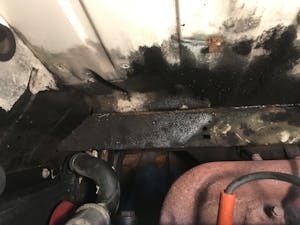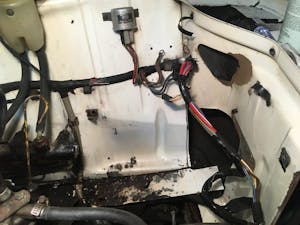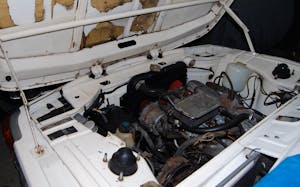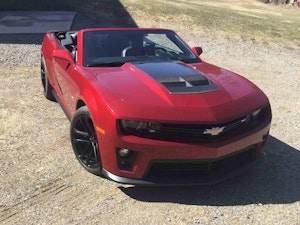Media | Articles
The slippery slope of engine compartment cleanup
Last September, in the good old pre-virus days—when you could drop everything, borrow a truck, rent a U-Haul auto transporter, drive 5 1/2 hours each way to look at a car (so you’re prepared, just in case you want to pull the trigger on it), drag the car back, and spend hours in a garage breathing the same air with someone you’ve never met—I bought a 48,000-mile 1973 BMW 2002 from its original owner.
The car was in very-good survivor condition, but one of the sticking points was that, in addition to the fact that it hadn’t run in a decade, the seller felt that the condition was “excellent” (the interior really was close to original mint) and saw big dollar signs in her eyes, whereas when I opened the engine compartment, it looked like any other 47-year-old car. Worse, in fact, there was a black pickup-truck-bedliner-like substance sprayed everywhere. The plainly visible black stuff behind the headlights stuck out like a sore thumb against the car’s white paint, but that was just the tip of the iceberg. I explained the problem to the seller. What brings the money on a car is a complete history without any red flags, and the story of this being a 48,000-mile, one-owner, essentially rust-free survivor car with zero accidents is thrown into question when this black stuff dominates the engine compartment.
It makes potential buyers wonder if it’s there to cover accident damage.

After a lengthy negotiation, I bought it, and over the winter have been trying to bring the engine compartment back to a condition commensurate with the rest of the car. It’s important to note that I don’t “restore” cars. I just try to resurrect them so that they become the best version of what they are. If it’s a ratty runner, great, but in this case the car has the potential to be a very attractive survivor. I had no expectations of getting the engine compartment to look like new—painting things like air cleaner housings and valve covers just makes the things you don’t paint stick out, and doing everything becomes a prohibitive amount of work—but certainly I could try to make it so that the engine compartment wasn’t literally a black mark on the car’s value.
It turned out that the black goo in the engine compartment wasn’t accident-damage-hiding pickup truck bedliner, but originally applied Ziebart rustproofing. When I looked, I found the plastic plugs in the holes that were drilled. One can certainly argue that the Ziebarting was a good thing and probably helped keep the rust in the nose and fenders down. But it had been applied with a firehose in plainly visible places that should’ve been white.
Marketplace
Buy and sell classics with confidence


I asked a friend of mine who does professional restoration work how to get the undercoating off, and he recommended a product called Kleen-Strip Prep-All Wax and Grease Remover. It’s available in both aerosol and liquid. I bought the spray can (four, in fact, by the time I was done). It worked great. By using paper towels and working methodically on one matchbook-sized section at a time, I was able to get all the visible Ziebart off. There were a few sections where the undercoating was on quite thick and had hardened. For these spots, I found that a guitar pick was effective in chipping it and prying it up.

Then I began approaching the slippery slope of the project. I was successful at removing all the “visible” undercoating, but of course what’s “visible” depends on where and how hard you look. I had no desire to begin disassembling the engine compartment, but, hey, it’s easy enough to unbolt the ignition coil and ballast resistor and clean behind them, right? On the opposite side of the engine compartment, though, was the brake master cylinder, and undercoating had been sprayed down beneath it. Initially I thought, “Well, that’s the water’s edge of my efforts; there’s not enough clearance to clean underneath it, and I’m certainly not pulling the master cylinder out.” However, through a combination of snaking my left arm under it, and rubber-banding folded paper towels to a wooden dowel and sliding it down, I was able to get all the undercoating cleaned out from under it.
But it’s a slippery slope because you find yourself sliding down it without realizing it. The only remaining undercoating in the main section of the engine compartment was under the battery tray, which is removable—it’s just held in by four 10mm bolts. The tray itself was in pretty sad condition, as the top of it was damaged by corrosion from battery acid. With the tray removed, it didn’t take long to clean the last of the undercoating.


But, having done this, was I going to reinstall this corroded scummy-looking battery tray against the now pretty white inner fender? I did a quick search on Craigslist (this was back in January, pre-virus) and found a guy about a half hour from me who had a small sandblasting cabinet. I sent him a photo of the tray and he offered to do it for 30 bucks. I immediately drove to see him. It turned out that underside of the tray still being coated with Ziebart was problematic; the blasting material basically just bounced off it. He heated it and scraped nearly all of it off, then sandblasted it clean. I tipped him 10 bucks for the extra level of effort. As soon as I got home, I primed the tray.

The car is painted Chamonix, a slightly creamy white color (BMW paint code 085). I ordered a $30 spray can of it on eBay, and when it arrived I gave the battery tray two coats. After it dried, I dropped it into the engine bay.
The color stuck out like a sore thumb. It was waaaaaay too white. Clearly the color was off. Oh well, I thought; that’s what I get for buying the lowest-price spray can of paint-coded paint on eBay when I need to match a color.

But then I pulled the tray back out and held it up against the exterior of the car. And there, it was a pretty good match. I realized that the problem was less the new Chamonix paint, and more the fact that the original paint in the engine compartment had darkened considerably, probably from the heat.
I asked some of my professional body shop friends on Facebook what to do about it, and the response was, essentially, “Welcome to the hell that is my world.” Folks explained that even under the best of circumstances, it’s challenging to match paint, that you can’t just buy a can of something with the code on it and expect it to be right, that you need to take the car to a shop which can photograph it and mix paint specifically to match, and that, even then, in an engine compartment the discoloration can vary even within a few inches. To get it right, you’d need to repaint not only the battery tray but the entire engine compartment.
Many of us know the rest of this song. Spit-balling some numbers, you can make the argument that a freshly-painted and nicely-detailed engine compartment might raise the value of a $20K car by, oh, say, five grand. Let’s say the cost of having a reputable shop peel back the engine compartment components and sandblast and spray the engine compartment is $3K. Makes sense, right? Oh, but the rest of the exterior of the car, while attractive, has a few dings and a minor scrape. Are you really going to drop coin on the engine compartment before the exterior? Before you know it, it’s a $25K glass-out paint job, and then all the original chrome looks terrible against it. And that’s why the whole invest-to-make-more thing only works if you own a body shop, or if your brother-in-law who owns one owes you big time because you never ratted him out when he stepped out on your sister.
This is why I don’t “restore cars.”
It is at this point that my automatic slippery slope detector gets triggered, and my ice axe and crampons automatically deploy.
I put the battery tray down for a bit to think about what was best to do. In the interim, the corona virus rolled in. This is germane because it prevented me from going into a hardware store and trying to match spray can caps to an engine compartment photo on my cell phone. I say “prevented.” That’s a relative term. I try to minimize both actual risk and my wife’s stress level, and going into a hardware store for spray paint for a battery tray definitely fell outside of what was “essential,” even by a car guy’s definition.
So I looked online and tried to match the color as best as I could. Surprisingly, even for something widely available like Rustoleum, I couldn’t find a useful color chart for their spray paints that showed a variety of whites. By trial and error, it looked like Navajo White was a decent match, at least as well as I could tell by holding the phone screen in the engine compartment. However, because of Amazon’s prioritizing shipment of essential COVID-19-related items, shipping times of non-essential stuff are longer, and the estimated delivery of the paint was more than a week.
I ordered it, but then had an idea: I called the nice folks at my local True Value hardware store, where I used to routinely go for things like fasteners, and I asked if they had Navajo White spray paint in stock and offered curbside pickup. They answered yes to both questions. I drove over, but someone had made a mistake; they had it in a liquid, but not aerosol. I asked the fellow to try and match the lid of the Navajo White liquid to a spray can as best he could. He came back with two cans, Rustoleum Ivory Bisque and Ivory Silk. At $4.98 a can, I bought both.
I got home and held the spray paint caps in the engine compartment. I still couldn’t really tell, as the plastic caps didn’t have any of the shine of the paint. I took a few pieces of scrap aluminum and painted one each color, let them dry, and held them where the battery tray would go. Silk was too dark, but Bisque looked fairly close.
So, I gave the tray a couple of quick coats of the Ivory Bisque and put it in. It was less jarring than when it was painted Chamonix, but it was still too light, and my eye was still drawn to it as being wrong.
Coincident with all this was a water pump replacement in the car, as the seal was intermittently leaking from its 10-year sojourn in storage. I had a spare aftermarket water pump in the garage, but when I was about to install it, its non-stock look and feel immediately put me off, and I made the highly unusual (at least for me) choice to send the original water pump to Flying Dutchman in Oregon for rebuild. To get the water pump out, I needed to remove the radiator, and doing so I exposed more Ziebart undercoating behind and beneath it. When I cleaned it off, I found a little surface corrosion. I thought, “You’re treating the rust on the battery tray. Why wouldn’t you do the same on the surface rust that’s actually on the body of the car?”

Now, normally when I find a little engine compartment or under-body surface rust I wire-wheel it and treat it with a rust converter like Loctite Extend or Rustoleum Rust Reformer. However, using a rust converter turns it black, which makes it even more visible against white paint. Another thing I’ll sometimes do is use an oil-based treatment like Kano Weatherpruf; I’ll routinely slather any surface rust on the undercarriage of a vintage car with it prior to a long road trip.
I thought about it very carefully, and in the end, I decided to do nothing. I figured if the goal is to present the car as a survivor, it’s better not to do anything that can be considered a booged repair and instead to leave that sort of decision to the next owner. Perhaps I should’ve made that same decision about the battery tray, but it really was pretty ugly.
By the time the water pump and radiator were back in the car, the can of Navajo White arrived from Amazon. I again painted a small scrap piece of metal and held it up where the tray would go. It did seem like a better match. So, for the third time, I sprayed the battery tray and put it in the engine compartment.
To my intense delight, it was a visibly better match. You could still tell it had been repainted, but that would’ve been the case even if the color match was perfect. The more important issue was that my eye was no longer drawn immediately toward it.

So, the engine compartment is not restored, or even close to being detailed, but I removed the visible Ziebart, got the battery tray repainted so that it doesn’t stick out, and generally cleaned things up without doing anything that takes the car down a path the next owner would object to.

In the meantime, what do I do with all this paint?

***
Rob Siegel has been writing the column The Hack Mechanic™ for BMW CCA Roundel magazine for 34 years and is the author of five automotive books. His new book, Resurrecting Bertha: Buying back our wedding car after 26 years in storage, is available on Amazon, as are his other books, like Ran When Parked. You can order personally inscribed copies here.

















